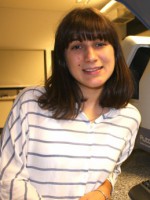abstract
Visible-light communications (VLCs) based on white light-emitting diodes (LEDs) are emerging as a low-cost and energy-efficient alternative solution to wireless communications. As white emitting LEDs use a combination of a long-lived yellow emission combined with the faster response of a blue emitting LED (similar to 460 nm), VLC technology requires amplification of the blue component to improve the signal-to-noise ratio. We report the fabrication and characterization of planar and channel waveguides based on a blue-emitting polyfluorene conjugated polyelectrolyte, namely, poly[9,9-bis(4-sulfonylbutoxyphenyl)fluorene-2,7-diyl-alt-1,4-phenylene] (PBS-PFP) incorporated into diureasil organic-inorganic hybrids for optical amplification in VLC. Taking advantage of the diureasil host as a UV self-patternable material, direct UV laser writing was used to pattern channel waveguides with a larger refractive index (Delta n=0.09) compared to the nonexposed region, enabling confinement and guidance of the PBS-PFP emission with a maximum optical gain efficiency value of 1.62 +/- 0.02 cm mu J-(1). This value is among the best figures of merit known for polymeric materials with additional advantages added by the diureasil hybrid host, namely, mechanical flexibility, thermal stability, and low insertion losses due to the nearly null refractive index contrast between the optical fiber and the amplification device, establishing the proposed approach as a promising cost-effective solution for optical amplification in VLCs.
keywords
WHITE-LIGHT; ORGANIC/INORGANIC HYBRIDS; COLOR-CONVERTER; WAVE-GUIDES; EMISSION; PHOTOLUMINESCENCE; LASER; GAIN; ARCHITECTURES; AMPLIFICATION
subject category
Chemistry
authors
Bastos, A; McKenna, B; Lima, M; Andre, PS; Carlos, LD; Evans, RC; Ferreira, RAS
our authors
acknowledgements
The authors acknowledge the Portuguese funds through FCT-Fundacao para a Ciencia e a Tecnologia, for financially supporting this research under the scope of Instituto de Telecomunicacoes/IT (UID/EEA/50008/2013) and CICECO-Aveiro Institute of Materials, POCI-01-0145-FEDER-007679 (FCT ref UID/CTM/50011/2013), financed by national funds through the FCT/MEC and when appropriate co-financed by FEDER under the PT2020 Partnership Agreement and project WinLED, no. 030351 (CENTRO-01-0145-FEDER-030351). A.B. acknowledges FCT for the grant PD/BD/105859/2014 (MAP-TELE) and Fundacao Calouste Gulbenkian for the "Premio de Estimulo a Investigacao 2015" (Proc no. 141767). This work was supported in part by the Science Foundation Ireland under Grant No. 12/IP/1608. The authors thank Dr. Ana-Teresa Marques and Prof. Ullrich Scherf for the provision of the PBS-PFP conjugated polyelectrolyte.




